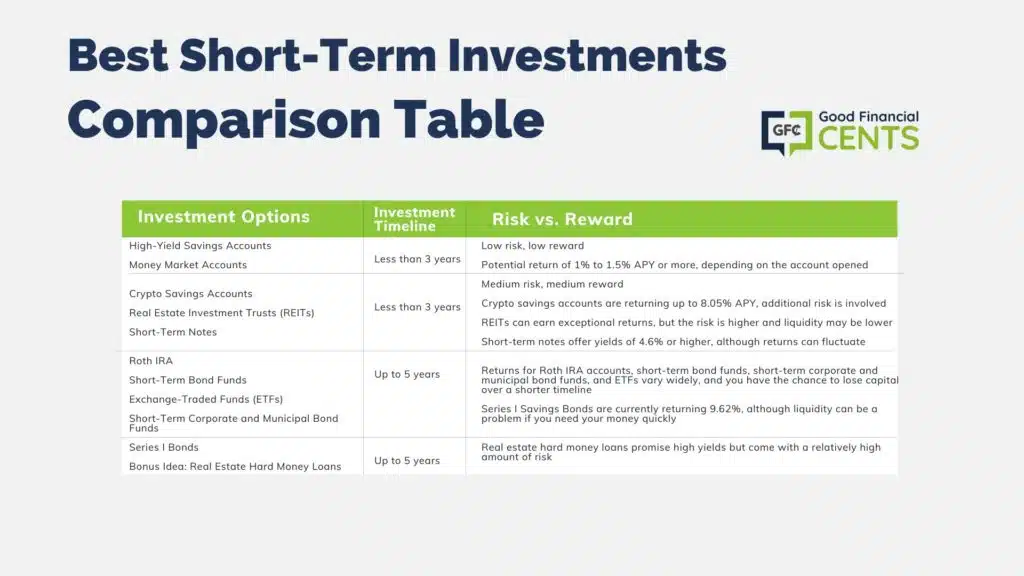By the end of 2021, the S&P 500 had risen 26.61%, and the Dow Jones Industrial Average had grown by 18.65%. For those who had just begun investing in the stock market, as well as investors who had considerable sums of money in equities, it almost felt as if one could do no wrong.
Fast forward to 2025, and it’s astounding how the tables have turned. Inflation is at a 40-year record high, and the markets are volatile, to say the least.
However, there are still plenty of ways to invest smartly, both for the short-term and the long-term. In fact, many of the best investments of 2025 are made to withstand turbulent times and to help you grow wealth regardless of market conditions.
To help you find the best place to stash your extra cash, we compared all the best investment strategies for 2025. Read on to learn about our top picks, who they’re best for, and how to get started.
| Investment | “Best for” Category | Investment Timeline |
|---|---|---|
| Crypto Savings Accounts | Passive Income | Short-Term |
| High-Yield Savings Accounts | Low Risk | Short-Term |
| Series I Savings Bonds | Short-Term Returns | Short-Term |
| Real Estate Investment Trusts (REITs) | Diversification | Long-Term |
| Stocks | Building Wealth | Long-Term |
| Exchange-Traded Funds (ETFs) | Tax Benefits | Long-Term |
Table of Contents
Our Picks for Best Investments for 2025
- Crypto Savings Accounts: Best for Passive Income
- High-Yield Savings Accounts: Best for Low Risk
- I-Bonds: Best Short-Term Returns
- Real Estate Investment Trusts (REITs): Best for Diversification
- Stocks: Best for Building Wealth
- Exchange-Traded Funds (ETFs): Best for Tax Benefits

The best investments can be different for everyone, mostly because each person has to tailor their investment strategy to their timeline, their goals, and their tolerance for risk. The following investments can work for the short-term or the long-term, depending on your needs.
Crypto Savings Accounts: Best for Passive Income
Crypto savings accounts offer a way to build passive income based on your crypto deposit. Plus, you can earn a much higher rate of return than you can with a traditional savings account.
For example, a Gemini Earn account lets you earn up to 8.05% APY on your cryptocurrency. This account even lets you redeem your crypto and move your balance back to your trading account (plus interest) at any time, and there are no minimums and no transfer or redemption fees to worry about.
Another popular crypto savings account comes from Crypto.com. This account lets you transfer your crypto, keep it on deposit, and earn up to 18.63% weekly on your deposits. Your return depends on the type of crypto you have, and some types of crypto earn considerably more than others.
For example, non-accredited investors are currently earning up to 7.10% on stablecoins like GUSD and PAX, while accredited investors are earning up to 9.32%. Current returns on bitcoin (BTC) work out to up to 6.50% for non-accredited investors and up to 8.53% for accredited investors.
Related:
High-Yield Savings Accounts: Best for Low Risk
If you’re looking for the best short-term investments with minimal risk, a high-yield savings account could be your best bet. These accounts don’t offer the best returns right now, but your assets are protected with FDIC insurance.
This insurance is good for up to $250,000 per depositor for each insured bank, and it means you won’t lose your cash if your bank defaults or goes out of business.
Many of the best high-yield savings accounts don’t have any account minimums or fees, and they do offer considerably higher rates than traditional banks.
For example, the Federal Deposit Insurance Corporation (FDIC) reported that the average savings account offered a yield of just .46% as of January 2024.
Meanwhile, the CIT Bank Savings Builder account is offering up to 4.95% APY with a minimum balance of $25,000 or a $100 monthly deposit requirement. And UFB Direct is offering 3.30% on their Rewards Savings program with no minimum investment.
With a High-Yield Savings Account, putting money aside just got easier.
If the idea of securing your future makes you stressed, let a High-Yield Savings Account put you at ease. Open your account today with Save Better.

5.26%
Interest Rate
varies
Min. Initial Deposit
Series I Savings Bonds: Best Short-Term Returns
If you have up to $10,000 to invest right now and you won’t need the money for at least one year, Series I Savings Bonds offer a low-risk way to invest. These bonds offer a combination of a fixed rate that stays the same for the life of the bond and an inflation rate that adjusts twice per year.
Currently, investors will receive a 7.12% return on their investment, yet this rate continues to adjust over time. Further, these bonds are not taxable on the state or local level.
Since Series I Savings Bonds are backed by the full faith and credit of the U.S. government, they come with minimal risk. However, it’s important to note that investors can only purchase up to $10,000 in Series I Savings Bonds per calendar year if bought electronically.
Real Estate Investment Trusts (REITs): Best for Diversification
If you have been considering real estate investing as a strategy to build long-term wealth, you should explore the possibility of investing in Real Estate Investment Trusts (REITs).
This type of investment works similarly to stocks, meaning you can buy in with a set amount of cash and wait for your investment to pay off without any hands-on work on your part.
REITs are also invested in various real estate projects, which can include commercial real estate or residential properties. For example, many REITs are made up of underlying investments in office buildings, retail buildings, warehouse or industrial space, or large apartment complexes.
REITs also function similarly to very high dividend-paying stocks, mainly because they require that at least 90% of their income must be returned to investors in the form of dividends. This can create tax consequences for the investor, but it also means that returns tend to be high.
If you’re having trouble picking a REIT, you can also look into real estate crowdfunding through platforms like Fundrise. This fintech company makes it easy to invest into real estate projects with as little as $10, and you don’t have to be an accredited investor to get started.
While returns for 2025 are down so far, Fundrise reported an average return for their clients of 1.5% in 2022, 28.71% in 2021, and 18.40% in 2020. You can also see my personal Fundrise returns here.
Stocks: Best for Building Wealth
If you’re hoping to begin building wealth with one of the best long-term investments, the stock market has historically been the best way to get started. The fact is, the average annual return on stocks is currently around 7%, although some measures put it closer to 10%.
Investing in stocks gives you the opportunity to build wealth as the economy grows, and the best online stock brokers for beginners let you get started with as little as $1, usually through fractional shares.
Getting started investing in stocks is also a breeze since you can open a brokerage account online and from the comfort of your home.
As an example, you can start investing in stocks with the best investment apps, or you can open an account with a brokerage firm such as Ally Invest, E*TRADE, or TD Ameritrade.
When it comes to investing in stocks, common investment strategies involve investing in growth stocks, dividend stocks, or both. Generally speaking, growth stocks are stocks of companies that focus on long-term growth, usually in the tech industry.
On the flip side, dividend stocks are issued by companies that return a substantial amount of net profits to shareholders but don’t necessarily focus on long-term growth.
With all this being said, you’ll have to have a basic understanding of what you’re investing in to get started and plenty of research is required. Before you invest in stocks, you’ll want to know and understand the background of any given company, as well as the future prospects of their operation.
While the latter always involves some form of educated guesswork, the former can be achieved by charting, which plots out historical market data as points in a graph to visualize how prices have changed over time.
Exchange-Traded Funds (ETFs): Best for Tax Benefits
An exchange-traded fund (ETF) is a portfolio that is made up of a large number of different stocks and bonds that typically track a specific market index. With that in mind, investing in ETFs lets you build long-term wealth in a diversified way.
Not only that, but the fact that ETFs are primarily index-based lets investors build a portfolio without having to worry whether individual stocks are a good investment.
Many ETFs align with index funds, but there are also sector ETFs, commodity ETFs, and even exchange-traded notes. ETFs are also considered a tax-efficient investment since they don’t have the kind of trading activity mutual funds do and since their expense ratios are low as a result.
ETFs are also inexpensive and easy to buy or sell, whether you’re building your investment portfolio on your own, with the help of the best robo advisors, or guided by a financial advisor.
Investing Guide
Whether you have a large sum of cash to invest or you’re looking for ways to invest small amounts of money, it helps to arm yourself with as much information as you can. Read on to learn how to invest money according to your goals and what you should know ahead of time.
How Does Investing Work?
Investing takes place when someone buys an asset at one price with the goal of selling it at a higher price. For example, investing can involve someone buying a particular stock, holding it for ten years, then selling it at a profit.
However, many investors make money by buying and selling stocks and other investments over a much shorter period of time — even within the same day.
Another example of investing is when a person uses their own money to buy real estate that they rent to someone else. In this case, the investor hopes the value of the property increases over time, yet they’re also receiving a return on their investment when their tenant pays rent each month.
The Benefits of Short and Long-Term Investing
Investing in the short-term is just as important as investing in the long-term, although each strategy can help you reach a different set of personal finance goals.
For example, short-term investing can help you ensure your money keeps up with inflation, and it can help you save up for goals like buying your first home or starting a business.
In the meantime, long-term investing is usually for retirement or for the purpose of building generational wealth.
A diversified portfolio with varied investment options can bring these long-term goals to fruition, and the bottom line is that investment strategies in this realm tend to come with more risk since you have a longer investment horizon in general.
Choosing the Right Investments
If you’re wondering how to invest money wisely, there’s an array of important factors to consider. Considering these factors can help you determine what to invest in today.
- Your Financial Goals: For starters, you should consider your investing goals, including whether you are investing for the short-term or for long-term goals like retirement.
This will help you determine what type of investment account to open, whether you need a brokerage account or a retirement account like a traditional IRA or a Roth IRA.
Depending on your goals, you may want to begin investing in workplace retirement plans you have access to first, such as an employer-based 401(k) plan.
- Available Resources: What type of investment has the highest return doesn’t matter as much as how much cash you have to invest.
You have to consider your available resources and purchasing power before you decide where to put your money, whether you’re looking for the best ways to invest $1,000, $5,000, $10,000, or your entire retirement portfolio.
- Risk Tolerance: Your tolerance for risk should also play a role in your investment strategy.
If you can’t afford to weather downturns or market fluctuations, you’ll need to go with relatively safe investments such as high-yield savings accounts, highly rated corporate bonds, Certificates of Deposit (CDs), government bonds, and money market accounts.
- Investment Timeline: Also consider your time horizon or when you’ll need the money you’re investing right now. If you are hoping to build long-term wealth for retirement, you can afford to take more risks with your investment choices.
The Risks of Investing
There are many inherent risks involved in investing your money, although specific risks depend on your investment strategy and where you decide to park your assets.
Many investment risks are largely out of your control, but it helps to know and understand the issues you’ll face once you learn about online investing and open an account.
- Volatility: As of this writing, the S&P 500 index is down more than 10% for the year, and that’s after a year of record stock market returns — Amazon, for instance, is one notably successful company in the index that recorded record profits during the height of the pandemic.
While stock market volatility tends to increase during times of economic turmoil or war, it’s crucial to understand that investing can be volatile and bumpy if you’re in it for the long haul.
- Economic Conditions: Economic conditions can also impact your investments, many of which are beyond your control. For example, the Federal Reserve raising interest rates seems to have impacted the real estate market in the short term.
Other economic conditions and factors, including government actions, can also impact investment returns.
- Liquidity Risk: Some investments are considerably more liquid than others, so make sure you know how easily you can access your money if you need to. In the meantime, it’s crucial to factor in the tax consequences of selling investments to lock in your gains.
- Opportunity Cost: Finally, remember that there is an opportunity cost involved any time you invest in one asset over another.
Charlie Munger famously said the following: “Opportunity cost is so simple. If you’re gonna make a new investment, your opportunity cost of the new investment is whatever the next best choice you have available is.”
How We Found the Best Investments for 2025
There are an endless number of ways you can invest your money, whether you are learning how to invest in stocks or you are hoping to build up your retirement accounts.
For the purpose of this guide, we focused on some of the best ways to invest for both the short-term and the long-term, with the goal of providing options that make sense for individuals with myriad goals.
We aimed to choose investments that promise a solid return on investment or a strong level of safety and security. We also looked for investments that are easy to access with a low barrier of entry to get started.
Summary of the Best Investments for 2025
- Crypto Savings Account: Best for Passive Income
- High-Yield Savings Account: Best for Low Risk
- Series I Savings Bond: Best for Short-Term Returns
- Real Estate Investment Trusts (REITs): Best for Diversification
- Stocks: Best for Building Long-Term Wealth
- Exchange-Traded Funds (ETFs): Best for Tax Benefits
Benefits and Risks of Investing
| BENEFITS | RISKS |
|---|---|
| Inflation Protection (Short-Term) | Volatility |
| Near-Term Goal Achievement | Economic Conditions |
| Retirement Savings (Long-Term) | Liquidity Risk |
| Generational Wealth Creation | Opportunity Cost |
| Diverse Portfolio Options |
The Bottom Line – Best Short and Long-Term Investments of 2025
In the rapidly changing financial landscape of 2025, characterized by soaring inflation and market volatility, identifying smart investment avenues is crucial.
While the past success of the S&P 500 and Dow Jones might have painted a rosy picture, current circumstances call for astute decision-making.
From the promise of passive income through Crypto Savings Accounts to the tax benefits of ETFs and the stability offered by High-Yield Savings Accounts and I-Bonds, there’s a diverse range of investment options tailored to individual needs, timelines, and risk tolerance.
Investors should weigh the benefits against inherent market risks, staying informed and strategically diversified to navigate and prosper amidst the prevailing uncertainties.







